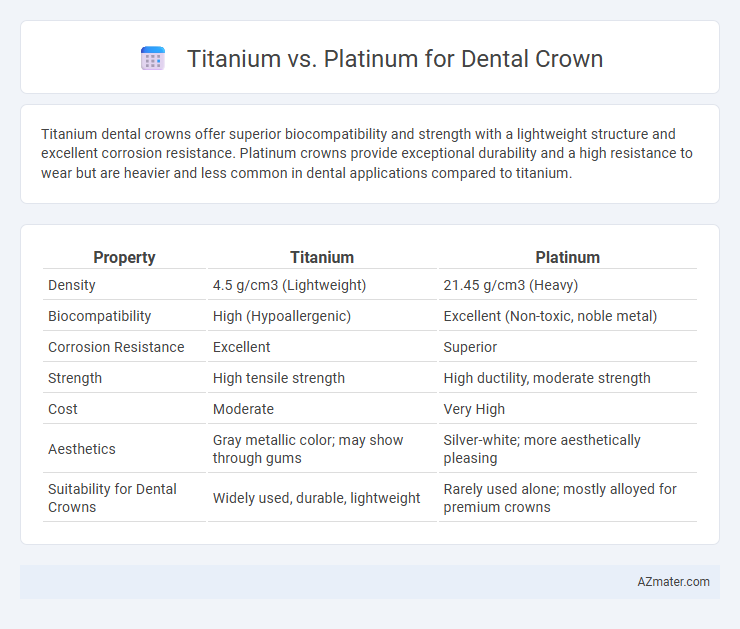Titanium dental crowns offer superior biocompatibility and strength with a lightweight structure and excellent corrosion resistance. Platinum crowns provide exceptional durability and a high resistance to wear but are heavier and less common in dental applications compared to titanium.
Table of Comparison
| Property | Titanium | Platinum |
|---|---|---|
| Density | 4.5 g/cm3 (Lightweight) | 21.45 g/cm3 (Heavy) |
| Biocompatibility | High (Hypoallergenic) | Excellent (Non-toxic, noble metal) |
| Corrosion Resistance | Excellent | Superior |
| Strength | High tensile strength | High ductility, moderate strength |
| Cost | Moderate | Very High |
| Aesthetics | Gray metallic color; may show through gums | Silver-white; more aesthetically pleasing |
| Suitability for Dental Crowns | Widely used, durable, lightweight | Rarely used alone; mostly alloyed for premium crowns |
Introduction to Dental Crowns
Dental crowns are essential restorations used to protect and enhance damaged or weakened teeth, offering durability and aesthetic appeal. Titanium crowns provide exceptional strength and biocompatibility, making them suitable for patients with metal sensitivities or those requiring robust support. Platinum crowns, although less common, offer superior corrosion resistance and a natural color that blends seamlessly with surrounding teeth.
Overview of Titanium and Platinum Materials
Titanium crowns are highly favored in dental restorations for their exceptional biocompatibility, corrosion resistance, and lightweight properties, making them ideal for patients with metal allergies. Platinum, although less common, offers superior strength, high density, and an impressive resistance to tarnishing, contributing to durable and long-lasting dental crowns. Both metals provide excellent support for dental prosthetics, but titanium's affordability and enhanced integration with bone tissue often make it the preferred choice for crown materials.
Biocompatibility: Titanium vs Platinum
Titanium exhibits exceptional biocompatibility in dental crowns due to its strong resistance to corrosion and ability to integrate with bone tissue, reducing the risk of allergic reactions and inflammation. Platinum, while also biocompatible, is less commonly used in dental crowns because it is denser and more expensive, with a higher thermal conductivity that may affect comfort. Titanium's superior osseointegration and hypoallergenic properties make it a preferred choice for dental restorations requiring long-term stability and patient safety.
Strength and Durability Comparison
Titanium dental crowns exhibit exceptional strength and biocompatibility, resisting wear and fracture under significant biting forces, making them highly durable for long-term use. Platinum crowns offer superior corrosion resistance and maintain structural integrity over extended periods, withstanding heavy chewing stresses without deforming. While both metals provide excellent durability, titanium's lightweight nature combined with its high tensile strength often results in crowns that endure rigorous oral conditions more effectively than platinum.
Aesthetic Considerations in Crowns
Platinum dental crowns offer superior aesthetic qualities due to their natural white color and excellent luster, closely mimicking the appearance of natural teeth, making them ideal for visible restorations. Titanium crowns, while highly durable and biocompatible, have a grayish hue that can sometimes show through translucent ceramic layers, potentially compromising the crown's natural look. For patients prioritizing aesthetics, especially in anterior teeth, platinum or porcelain-fused-to-platinum crowns provide a more visually appealing outcome compared to titanium-based options.
Corrosion Resistance in Oral Environments
Titanium dental crowns exhibit exceptional corrosion resistance due to the formation of a stable titanium oxide layer that protects against oral fluids and bacterial activity. Platinum crowns also offer high corrosion resistance, benefiting from platinum's noble metal properties that prevent oxidation and degradation in the moist, acidic oral environment. Comparative studies show titanium's biocompatibility and corrosion resistance make it a cost-effective alternative, while platinum crowns provide superior longevity and minimal ion release.
Cost Differences: Titanium vs Platinum
Titanium dental crowns generally cost significantly less than platinum crowns due to titanium's widespread availability and lower manufacturing expenses. Platinum crowns are priced higher because of the metal's rarity, superior durability, and biocompatibility, which justifies the premium cost in dental restorations. Choosing between titanium and platinum crowns depends on balancing budget constraints with desired longevity and material properties.
Procedure and Ease of Placement
Titanium dental crowns require a straightforward placement procedure due to the metal's biocompatibility and excellent osseointegration, allowing for secure bonding with the tooth structure. In contrast, platinum crowns, though less common, involve a more specialized technique as their density and malleability demand precise handling to achieve optimal fit and finish. Overall, titanium crowns offer enhanced ease of placement and reduced chair time compared to platinum, making them a preferred choice in clinical practice.
Long-Term Performance and Maintenance
Titanium dental crowns offer exceptional biocompatibility and corrosion resistance, ensuring long-term durability with minimal maintenance required. Platinum crowns provide superior strength and wear resistance but may require more frequent professional check-ups due to potential metal ion release and higher cost of upkeep. Both metals excel in longevity, but titanium's lightweight nature and stability often result in easier long-term maintenance for patients.
Choosing the Right Material for Your Dental Crown
Titanium offers exceptional strength, biocompatibility, and corrosion resistance, making it ideal for patients with metal allergies or those seeking durable dental crowns. Platinum provides superior aesthetics with its natural white luster and is highly resistant to tarnish, often preferred for visible crowns in the front teeth. Selecting the right material depends on factors such as location of the crown, patient sensitivity, and desired appearance, ensuring optimal longevity and functionality.

Infographic: Titanium vs Platinum for Dental Crown
 azmater.com
azmater.com